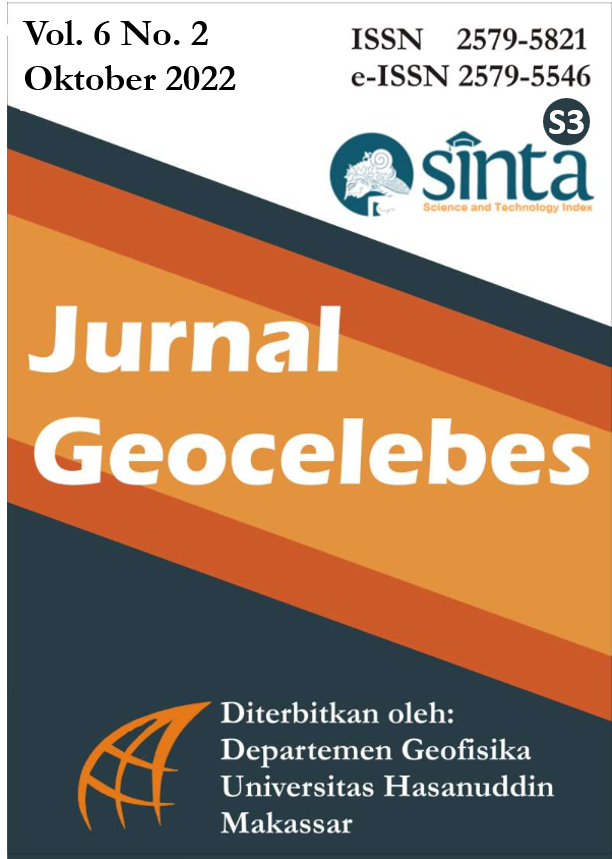Tyre Drop Structure Design for Erosion Handling in Mine Rehabillitation Area
Desain Tyre Drop Structure untuk Penanganan Erosi pada Area Rehabilitasi Tambang
DOI:
https://doi.org/10.20956/geocelebes.v6i2.21106Keywords:
conservation, terracering, supercritical, channel, rehabilitationAbstract
Mining activities require large work areas that potentially cause environmental problems. One of the impacts that can be caused is an increase of erosion rate, which can reduce the function of the land, especially in the location that planned to be mine rehabilitation area. The potential for erosion formed must be predicted to prepare methods of prevention. Estimation of erosion potential was carried out at Tiung AB Dump PT. Kaltim Prima Coal uses the RUSLE (Revised Unified Soil Loss Equation) method which considers rain erosivity, material erodibility, slope factor, vegetation factor and conservation factor. Based on the results of the study, the average erosion rate was 292.4 tons/ha/month with a catchment area of 0.674 km2. Erosion reduction uses a conservation technique using the terracing method which is supported by the construction of an open channel to drain the rain discharge that enters the catchment area. Rainfall uses data from the last 15 years with the highest rainfall in January of 231.9 mm/month and the lowest in September of 118.3 mm/month. The 10-year return period of the highest rainfall is 121.49 mm/day. Peak runoff rainfall is 13.22 m3/s with infiltration discharge is 9.72 m3/s. The designed open channel has a flow rate of 21.09 m3/s with supercritical flow. The use of a tire drop structure can reduce the speed up to 3.8 m/s which is within the permissible speed based on the type of material so that erosion can be reduced to 11.7 tons/ha/month or 96% of the natural erosion rate.Downloads
References
Apriadi, D., Kurniawan, M., Sumarjono dan Tanzilullah. 2017. Technical Mining Operation Division Handbook. Sangatta: PT. Kaltim Prima Coal.
Fadda, S., Fiori, M. and Matzuzzi, C. 2010. Developing rehabilitation design for the abandoned mine excavations in Central Sardinia, Italy. International Journal of Mining, Reclamation and Environment. 24(4), pp.286 – 306. https://doi.org/10.1080/17480931003775607
Hancock, G.R., Duque, J.M. dan Willgoose, G.R. 2020. Mining rehabilitation Using geomorphology to engineer ecologically sustainable landscapes for highly disturbed lands. Ecological Engineering. 155(15), pp.105836. https://doi.org/10.1016/j.ecoleng.2020.105836
Hancock, G.R., Lowry, J.C. dan Coulthard, T.J. 2015. Catchment reconstruction – erosional stability at millennial time scales using landscape evolution models. Geomorphology. 231, pp.15 – 27. https://doi.org/10.1016/j.geomorph.2014.10.034
Molla, T. dan Shiseber, M. 2016. Estimating Soil Erosion Risk and Evaluating Erosion Control Measures for Soil Conservation Planning at Koga Watershed, Highlands of Ethiopia. Solid Earth. 8(1), pp.13 – 25. https://doi.org/10.5194/se-8-13-2017
Nabi, G., Hussain, F., Wu, R.-S., Nangia, V., Bibi, R. dan Majid, A. 2017. Optimizing micro watershed management for soil erosion control under various slope gradient and vegetation cover conditions using SWAT modeling. Hydrology and Earth System Sciences Discussions. Preprint. https://doi.org/10.5194/hess-2017-532
Renard, K., Foster, G., Essies, G., McCool, D. dan Yoder, D. 1997. Predicting soil erosion by water: a guide to conservation planning with the Revised Universal Soil Loss Equation (RUSLE). United States Government Printing.
Sukardi, N., Sikumbang, I., Umar dan Sunaryo, R. 1995. Peta Geologi Lembar Sangatta. Bandung: Pusat Penelitian dan Pengembangan Teknologi.
Syukur, S. (2009). Laju infiltrasi dan peranannya terhadap pengelolaan daerah aliran sungai Allu-Bangkala. Agroland. 16(3), pp.231 – 236. http://jurnal.untad.ac.id/jurnal/index.php/AGROLAND/article/view/251
USDA. 2007. Stream Restoration Design National Engineering Handbook. Washington D.C: Natural Resouces Conservation Service.
Wantzen, K.M. dan Mol, J.H. 2013. Soil Erosion from Agriculture and Mining: A Threat to Tropical Stream Ecosystems. Agriculture. 3(4), pp.660 – 683. https://doi.org/10.3390/agriculture3040660
Downloads
Published
How to Cite
Issue
Section
License
Authors who publish with this journal agree to the following terms:
- Authors retain copyright and grant the journal right of first publication with the work simultaneously licensed under a Creative Commons Attribution License that allows others to share the work with an acknowledgement of the work's authorship and initial publication in this journal.
- Authors are able to enter into separate, additional contractual arrangements for the non-exclusive distribution of the journal's published version of the work (e.g., post it to an institutional repository or publish it in a book), with an acknowledgement of its initial publication in this journal.
- Authors are permitted and encouraged to post their work online (e.g., in institutional repositories or on their website) prior to and during the submission process, as it can lead to productive exchanges, as well as earlier and greater citation of published work (See The Effect of Open Access).



